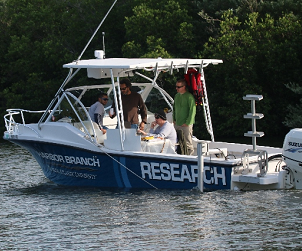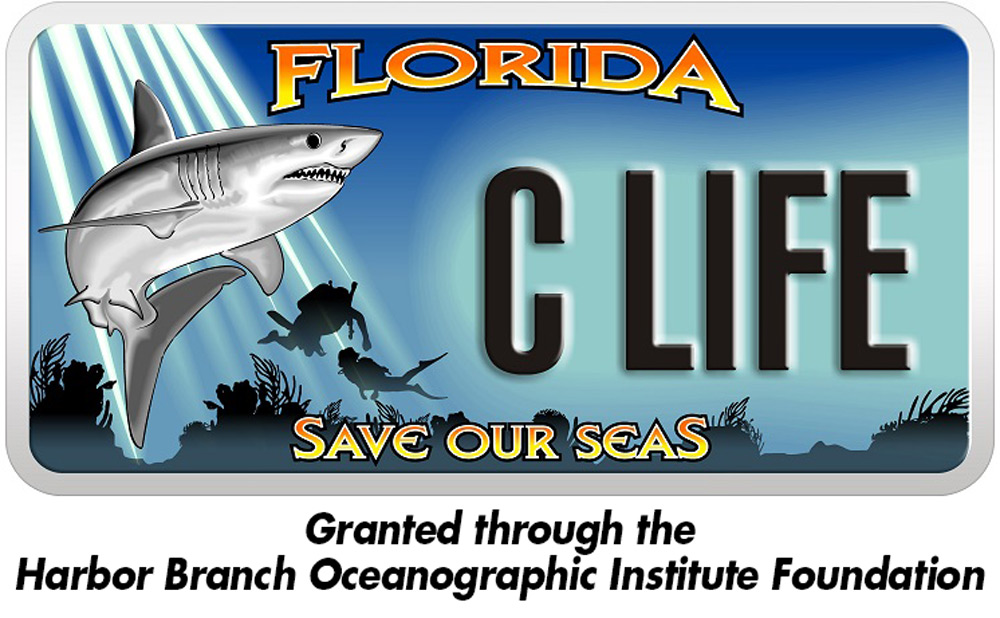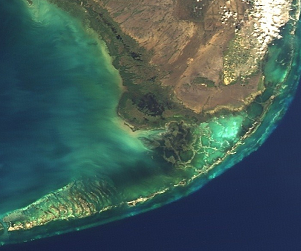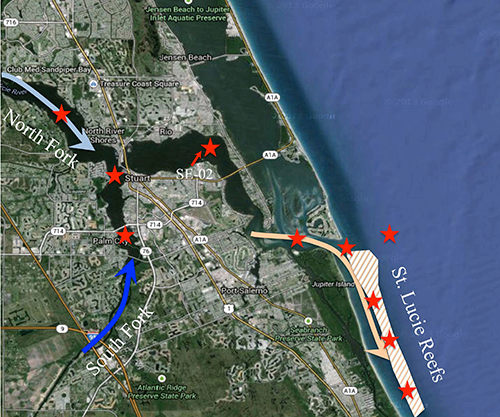Ocean Dynamics & Modeling projects
Ventilation rates of the Indian River Lagoon through its inlets
Just as humans need fresh air to live, the health of the Indian River Lagoon (IRL) depends in part on the exchange of water through its inlets, with high tides pushing in fresh ocean water and low tides drawing out water that is less beneficial to  lagoon life. Although some research has sought to quantify this vital process, little is known about how it varies naturally by season and as a consequence of land-based water management decisions. To address this gap, Associate Research Professor Laurent Chérubin, Ph.D., is leading a study of IRL inlet ventilation rates supported by sales of Save Our Seas license plate sales.
lagoon life. Although some research has sought to quantify this vital process, little is known about how it varies naturally by season and as a consequence of land-based water management decisions. To address this gap, Associate Research Professor Laurent Chérubin, Ph.D., is leading a study of IRL inlet ventilation rates supported by sales of Save Our Seas license plate sales.
The initial focus of the work is water exchange through the Fort Pierce Inlet, which will be measured and modeled over the course of a year with methods that include: 1) an array of 10 drifters that will be tracked over 12-hour deployments via GPS and unmanned aerial vehicle (UAV, or drone) technology, 2) bottom-mounted sensor units that measure current, depth, salinity, temperature, and other parameters, 3) deployment of an acoustic Doppler current profiler to measure water velocities during different tidal periods, 4) UAV surveys with a camera capable of generating images that characterize water contents such as chlorophyll and total suspended sediments, 5) hydrodynamic modeling of the tides, freshwater plumes, and wind-driven currents to have a systematic view of the water exchanges over tidal and seasonal cycles, and 6) measurements from existing sensor sites including the Harbor Branch land/ocean biogeochemical observatories.

Associate Research Professor Laurent Chérubin, Ph.D., is the principal investigator, and his collaborators include Ocean Dynamics & Modeling colleague and Associate Research Professor Mingshun Jiang, Ph.D., and, from the Harbor Branch Ocean Visibility & Optics Lab, Associate Research Professor Fraser Dalgleish, Ph.D., and Assistant Research Professors Anni Vuorenkoski Dalgleish, Ph.D., and Bing Ouyang, Ph.D. The group also will be working with FAU Department of Geosciences Assistant Professor Caiyun Zhang, Ph.D. Once the methodology is proven, the plan is to begin characterizing tidal exchange at the other IRL inlets.
Integrated models for evaluating climate change, population growth, & water management effects on south Florida coastal marine & estuarine ecosystems (iMODEC)
 The main objective of iMODEC was to understand the effect of future climatic variations on south Florida’s vulnerable coastal marine/estuarine ecosystems and on the sustainability of key commercial and recreational fishery species, focusing on Florida Bay as a major nursery ground for many fishery species. Climatic variations, including changes in precipitation, temperature, and evaporation, will interact with water management strategies planned as part of the Comprehensive Everglades Restoration Plan (CERP) to alter temperature and salinity regimes of Florida Bay, making it impossible to evaluate impacts on fishery habitat when examining either driver in isolation. Given that CERP partially evaluates restoration effectiveness with salinity targets and that many south Florida species reside near their maximum thermal limits, a better understanding of how changing climatic conditions interact with CERP to affect salinity and temperature regimes will improve water management decisions.
The main objective of iMODEC was to understand the effect of future climatic variations on south Florida’s vulnerable coastal marine/estuarine ecosystems and on the sustainability of key commercial and recreational fishery species, focusing on Florida Bay as a major nursery ground for many fishery species. Climatic variations, including changes in precipitation, temperature, and evaporation, will interact with water management strategies planned as part of the Comprehensive Everglades Restoration Plan (CERP) to alter temperature and salinity regimes of Florida Bay, making it impossible to evaluate impacts on fishery habitat when examining either driver in isolation. Given that CERP partially evaluates restoration effectiveness with salinity targets and that many south Florida species reside near their maximum thermal limits, a better understanding of how changing climatic conditions interact with CERP to affect salinity and temperature regimes will improve water management decisions.
Eight species were modeled in this study: mojarra (Eucinostomus spp.) pinfish (Lagodon rhomboides), rainwater killifish (Lucania parva), goldspotted killifish (Floridichthys carpio), pink shrimp (Farfantepenaeus duorarum), spiny lobster (Panulirus argus), spotted seatrout (Cynoscion nebulosus), and gray snapper (Lutjanus griseus). The latter four support valuable commercial and recreational fisheries, while the first four are primary prey species for commercial and recreational fishery species. Additionally, both pink shrimp and spotted seatrout are indicator species used to determine the success of CERP. To date we have been working with the US Army Corps of Engineers, National Park Service and South Florida Water Management District to employ products developed in conjunction with this project to help inform selection of the design configuration for the next stage of CERP. Specifically, the habitat suitability index model for spotted seatrout and the production model for pink shrimp have been applied to examine the ecological benefits of different possible design scenarios and inform the decision to develop a tentatively selected plan for the Central Everglades Planning Project, which is the next phase of CERP. Building upon this transfer to management, simulation outputs will be used to produce decision support tools predicting the potential impact of CERP on the vulnerability and health of south Florida’s marine ecosystem.
Associate Research Professor Laurent Chérubin, Ph.D., is the principal investigator, and his collaborators include Maria Criales, Ph.D. (U. of Miami), Kelly Kearney, Ph.D. (U. of Washington), Christopher Kelble, Ph.D. (NOAA-AOML), Joan Browder, Ph.D. (NOAA-NMFS), and Robert Burgman, Ph.D (Florida International U.).
Water quality impacts of St. Lucie river plume on the northern end of the Florida Reef Tract
 The St. Lucie Reef, the northern end of the Florida Reef Tract that encircles southeastern Florida, hosts abundant and diverse benthic and fish communities and is critical to the local economy. It is also subject to significant pressure from land-based nutrients and other pollutants via freshwater inputs the St. Lucie Estuary watershed and Lake Okeechobee. These land-based discharges also carry enriched CO2 that may significantly reduce the water pH and aragonite saturation state, and hence are detrimental to the health of reef building species as well as the stability of the reef structure. Yet, there is little information regarding the water quality parameters, particularly carbonate chemistry, in the estuary and over the reef area. This project aims to fill this information gap and to elucidate the causes and the effects of the pollution on the reefs.
The St. Lucie Reef, the northern end of the Florida Reef Tract that encircles southeastern Florida, hosts abundant and diverse benthic and fish communities and is critical to the local economy. It is also subject to significant pressure from land-based nutrients and other pollutants via freshwater inputs the St. Lucie Estuary watershed and Lake Okeechobee. These land-based discharges also carry enriched CO2 that may significantly reduce the water pH and aragonite saturation state, and hence are detrimental to the health of reef building species as well as the stability of the reef structure. Yet, there is little information regarding the water quality parameters, particularly carbonate chemistry, in the estuary and over the reef area. This project aims to fill this information gap and to elucidate the causes and the effects of the pollution on the reefs.
Data collection will include collection of water samples and use of a light-weight tow vehicle outfitted with a suite of automatic water quality sensors to measure dissolved oxygen, temperature, conductivity, depth, CDOM, chlorophyll, turbidity, pH, and pCO2. A coupled physical-biogeochemical model will be developed and numerical simulations will be carried out to simulate the freshwater plume over the survey period. A water quality model will be developed to represent the basic lower food web in the study area including nitrate (and nitrite), ammonium, three types of phytoplankton (diatoms, dinoflagellates, cyanobacteria), and two groups of zooplankton (micro- and meso-zooplankton). The model will also include a carbon component that tracks the carbon cycle including air-sea fluxes, land-based input, and internal carbon cycle. Finally, a sediment module will be included to simulate the benthic digenesis processes and the sediment-water coupling.
![]()

Principal Investigators: Mingshun Jiang, Ph.D., Brian Lapointe, Ph.D.
